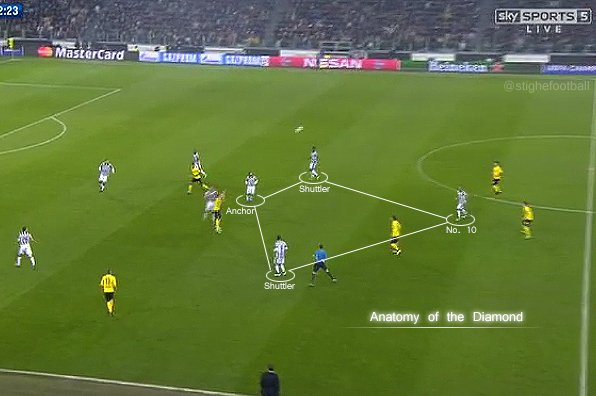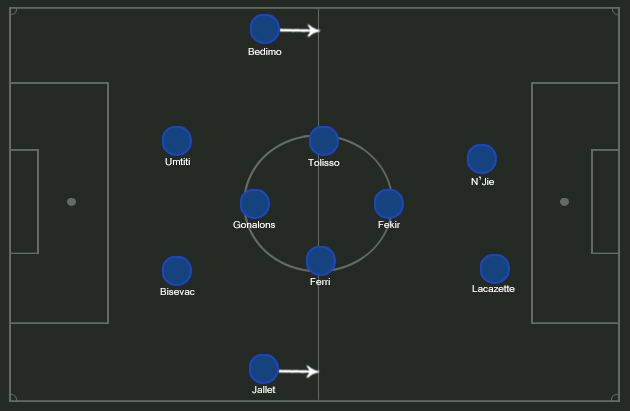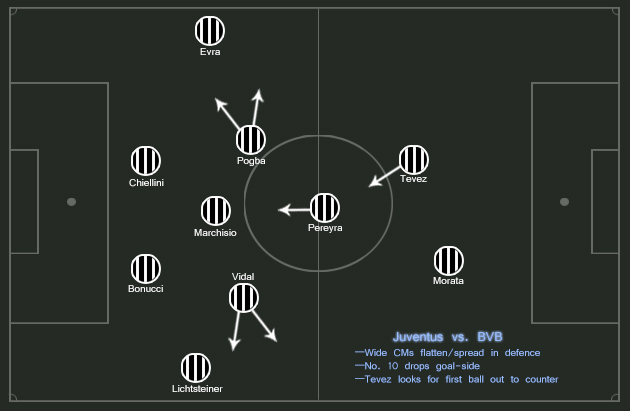William Henry Foulkes
Big Member
Presuming we will we basically be reverting to 4-4-2 next season. Pretty sure Adkins has said he prefers the diamond. Tried to find out what it is and came across the following (it looks like Hammond would fit right in).
http://bleacherreport.com/articles/...balls-in-vogue-formation-the-midfield-diamond
What do Liverpool, Juventus, Swansea City, Lyon, Borussia Dortmund, Sampdoria and Internazionale all have in common this season? They've all played, at least for a small segment of the season, in a 4-4-2 diamond formation. Heck, even Tim Sherwood has tried it with Aston Villa.
It's the fashionable formation of 2015. Managers and coaches see others performing well in a certain shape and decide they'd like to see their team do it all the time—case in point: Brendan Rodgers' obsession with Basel's 3-4-3—and this year, the diamond has made huge strides forward thanks to several key and successful deployments.
The diamond, or 4-3-1-2, has been around for quite some time, but football is a cyclical beast and trends are revived from the wilderness; there are very few "new" elements to the game. Pep Guardiola is hailed as a tactical innovator, but he's been thumbing through the pages of history since he was installed as Barcelona boss, reviving certain approaches and systems from bygone eras to see if they will work.
Every strategy needs tweaking, but it just so happens the state of play—and in particular, the state of midfield and full-back play—lends itself rather graciously to the deployment of the diamond. Players in 2015 have the right tendencies to play it, so it has stuck where others have fallen away.
Juventus are perhaps the flagship case study this year when it comes to making it a success. Not only are they runaway leaders at the top of Serie A, they have one foot in the UEFA Champions League semi-finals, firmly announcing their return to prominence on the European stage.

Credit: Sky Sports 5
The keys to the formation remain the same as most: even defensive zonal coverage across the pitch, the creation of width and the linking of the three (or four) lines. On paper, it's very simple. In practice, however, it takes a while to perfect.
The diamond essentially demands a front two, which is an immediate zone of discomfort for many teams in the modern era. One-striker formations (such as 4-2-3-1 and 4-3-3) have dominated the horizon for at least half a decade, and some managers are unwilling to play two up front due to the space it could conceivably leave in midfield.
But the diamond sacrifices natural width (no wingers) in favour of two strikers and four central midfielders. It tasks every player outside of the anchor midfielder and the two centre-backs to create width by darting wide.
This works both offensively and defensively, and it demands tactical intuition and smarts from the players. The full-backs sear forward in attack and play a near byline-to-byline role, holding the width up and down the pitch and providing crosses for the strikers. The outside central midfielders (shuttlers) must dart out to join them and create numerical overloads while also covering the gaps the full-backs leave if necessary.

@stighefootball
The anchor midfielder will rarely, if ever, surge forward, often sitting in front of the centre-backs or slotting in between them to allow them to push out to a temporary back three. Balance, and even zonal coverage, is key.
The outside central midfielders have to be pure athletes; the amount of running (with and without the ball) and fanning wide they have to dooff the ball to protect their full-backs is remarkable. Juventus have Paul Pogba, Claudio Marchisio, Arturo Vidal, Roberto Pereyra and Kwadwo Asamoah. Massimiliano Allegri has merely accepted he has the players made for the system and put it into place at Juventus Stadium.
That protection of the full-backs is mightily important. When the diamond defends, the deeper three midfielders fan out into a flatter line and the wider CMs move all the way out to track opposing full-backs and stop two-on-one overloads against their own defenders. If they're able to intercept and grab it, they'll immediately dribble north and initiate a counter.

@stighefootball
While the shuttlers' roles are almost always the same, there's some variation to be found in the others. Juventus play a defensive No. 10 in Pereyra, but Liverpool utilised a wonderful, creative type in Philippe Coutinho last year. Sherwood uses Jack Grealish, a player more akin to Coutinho, but Dortmund have sometimes used Henrikh Mkhitaryan, who will run, press and harass as well as create.
In the anchor role, Juve switch between Marchisio and Andrea Pirlo, with the difference in the two players speaking for itself. Swansea use a mediator in the form of Ki Sung-Yueng or Jack Cork, while Lyon use true anchor Maxime Gonalons or Corentin Tolisso, who does a bit of everything well.
The diamond is always at its best on the counter-attack, as, like an accordion, it shrinks during the defensive phase then expands outward going forward. It encourages high-quality transition football—something Liverpool perfected in 2013-14 under Brendan Rodgers—with players in the mould of Jordan Henderson dealing out great amounts of damage within it.
Therefore, it encourages quicker, niftier attackers. Juve have used Carlos Tevez and Alvaro Morata (one drops in to collect passes; one uses immense movement to hit the channels and stretch the opposition), while Liverpool's Daniel Sturridge-Luis Suarezcombination was fearsome to say the least.
Rodgers tried to marry Mario Balotelli with Sturridge early this season, but the experiment was forcibly ended by injury. There's a place for target man if used correctly—Fernando Llorente is serviceable in the system—but it's easier with two smaller men who are happy to flit about and play an inventive game.
The formation, on paper, looks entirely unbalanced due to the lack of wingers, and it also looks as though the full-backs will be ripe for exposure. But the system operates differently in every phase, and a good diamond will protect itself in every situation, pulling bodies around to cover gaps before intercepting and exploding forward.
There's rarely a dull game when one team is playing a diamond, and it's becoming more and more popular after several very successful executions of it. We could feasibly see two teams, Juventus and Lyon, win their respective domestic leagues with it in 2014-15, and Liverpool came oh so close last year.
Ligue 1 has opened its eyes to the diamond after sticking steadfastly to the 4-2-3-1 for a number of years, and it won't surprise to see more divisions follow suit. The knock-on effect will become an interesting study. Will it seal the true return of strike partnerships at the top level?
http://bleacherreport.com/articles/...balls-in-vogue-formation-the-midfield-diamond
What do Liverpool, Juventus, Swansea City, Lyon, Borussia Dortmund, Sampdoria and Internazionale all have in common this season? They've all played, at least for a small segment of the season, in a 4-4-2 diamond formation. Heck, even Tim Sherwood has tried it with Aston Villa.
It's the fashionable formation of 2015. Managers and coaches see others performing well in a certain shape and decide they'd like to see their team do it all the time—case in point: Brendan Rodgers' obsession with Basel's 3-4-3—and this year, the diamond has made huge strides forward thanks to several key and successful deployments.
The diamond, or 4-3-1-2, has been around for quite some time, but football is a cyclical beast and trends are revived from the wilderness; there are very few "new" elements to the game. Pep Guardiola is hailed as a tactical innovator, but he's been thumbing through the pages of history since he was installed as Barcelona boss, reviving certain approaches and systems from bygone eras to see if they will work.
Every strategy needs tweaking, but it just so happens the state of play—and in particular, the state of midfield and full-back play—lends itself rather graciously to the deployment of the diamond. Players in 2015 have the right tendencies to play it, so it has stuck where others have fallen away.
Juventus are perhaps the flagship case study this year when it comes to making it a success. Not only are they runaway leaders at the top of Serie A, they have one foot in the UEFA Champions League semi-finals, firmly announcing their return to prominence on the European stage.

Credit: Sky Sports 5
The keys to the formation remain the same as most: even defensive zonal coverage across the pitch, the creation of width and the linking of the three (or four) lines. On paper, it's very simple. In practice, however, it takes a while to perfect.
The diamond essentially demands a front two, which is an immediate zone of discomfort for many teams in the modern era. One-striker formations (such as 4-2-3-1 and 4-3-3) have dominated the horizon for at least half a decade, and some managers are unwilling to play two up front due to the space it could conceivably leave in midfield.
But the diamond sacrifices natural width (no wingers) in favour of two strikers and four central midfielders. It tasks every player outside of the anchor midfielder and the two centre-backs to create width by darting wide.
This works both offensively and defensively, and it demands tactical intuition and smarts from the players. The full-backs sear forward in attack and play a near byline-to-byline role, holding the width up and down the pitch and providing crosses for the strikers. The outside central midfielders (shuttlers) must dart out to join them and create numerical overloads while also covering the gaps the full-backs leave if necessary.

@stighefootball
The anchor midfielder will rarely, if ever, surge forward, often sitting in front of the centre-backs or slotting in between them to allow them to push out to a temporary back three. Balance, and even zonal coverage, is key.
The outside central midfielders have to be pure athletes; the amount of running (with and without the ball) and fanning wide they have to dooff the ball to protect their full-backs is remarkable. Juventus have Paul Pogba, Claudio Marchisio, Arturo Vidal, Roberto Pereyra and Kwadwo Asamoah. Massimiliano Allegri has merely accepted he has the players made for the system and put it into place at Juventus Stadium.
That protection of the full-backs is mightily important. When the diamond defends, the deeper three midfielders fan out into a flatter line and the wider CMs move all the way out to track opposing full-backs and stop two-on-one overloads against their own defenders. If they're able to intercept and grab it, they'll immediately dribble north and initiate a counter.

@stighefootball
While the shuttlers' roles are almost always the same, there's some variation to be found in the others. Juventus play a defensive No. 10 in Pereyra, but Liverpool utilised a wonderful, creative type in Philippe Coutinho last year. Sherwood uses Jack Grealish, a player more akin to Coutinho, but Dortmund have sometimes used Henrikh Mkhitaryan, who will run, press and harass as well as create.
In the anchor role, Juve switch between Marchisio and Andrea Pirlo, with the difference in the two players speaking for itself. Swansea use a mediator in the form of Ki Sung-Yueng or Jack Cork, while Lyon use true anchor Maxime Gonalons or Corentin Tolisso, who does a bit of everything well.
The diamond is always at its best on the counter-attack, as, like an accordion, it shrinks during the defensive phase then expands outward going forward. It encourages high-quality transition football—something Liverpool perfected in 2013-14 under Brendan Rodgers—with players in the mould of Jordan Henderson dealing out great amounts of damage within it.
Therefore, it encourages quicker, niftier attackers. Juve have used Carlos Tevez and Alvaro Morata (one drops in to collect passes; one uses immense movement to hit the channels and stretch the opposition), while Liverpool's Daniel Sturridge-Luis Suarezcombination was fearsome to say the least.
Rodgers tried to marry Mario Balotelli with Sturridge early this season, but the experiment was forcibly ended by injury. There's a place for target man if used correctly—Fernando Llorente is serviceable in the system—but it's easier with two smaller men who are happy to flit about and play an inventive game.
The formation, on paper, looks entirely unbalanced due to the lack of wingers, and it also looks as though the full-backs will be ripe for exposure. But the system operates differently in every phase, and a good diamond will protect itself in every situation, pulling bodies around to cover gaps before intercepting and exploding forward.
There's rarely a dull game when one team is playing a diamond, and it's becoming more and more popular after several very successful executions of it. We could feasibly see two teams, Juventus and Lyon, win their respective domestic leagues with it in 2014-15, and Liverpool came oh so close last year.
Ligue 1 has opened its eyes to the diamond after sticking steadfastly to the 4-2-3-1 for a number of years, and it won't surprise to see more divisions follow suit. The knock-on effect will become an interesting study. Will it seal the true return of strike partnerships at the top level?


